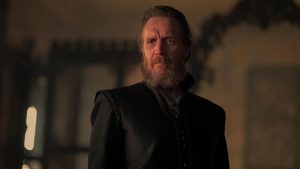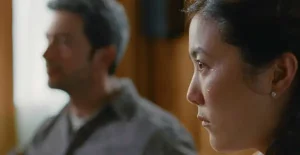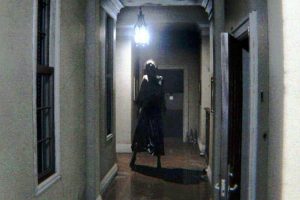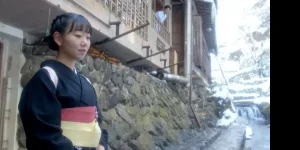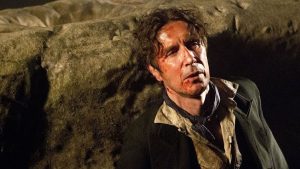This article includes spoilers for the House of the Dragon season 2 premiere.
An important character in the House of the Dragon season 2 premiere just died. Unto itself this shouldn’t feel like a surprise. The world of George R.R. Martin’s A Song of Ice and Fire and Game of Thrones is replete with tragic ends for folks the audience adores: Noble Eddard Stark beheaded in front his daughters; Prince Oberyn Martell, the dashing Red Viper, having his skull turned to red mist seconds before achieving his revenge; and pretty much everyone who stayed for supper at Walder Frey’s.
Martin’s fictional universe is much like our real one—it’s filled with injustice and bitterly unhappy endings. Even so, there was something particularly depraved about what just occurred in the House of the Dragon season 2 episode 1 “A Son for a Son,” an hour of TV that culminated in young Prince Jaehaerys Targaryen being slaughtered in his childhood bed. In an act so brutal that even a Game of Thrones-adjacent show felt the need to look away, a little boy is felled upon by assassins who dismember him as his mother helplessly looks on.
For readers of the source material that inspired House of the Dragon, Martin’s Fire & Blood, it is a moment that’s long been dreaded and anticipated in equal measure. And with good reason. Like the Red Wedding—or for that matter the “Purple Wedding” where King Joffrey is poisoned after his own nuptials or the “Green Trial” where Queen Cersei provides an ingenious legal defense—it is a shocking twist of fate that’s executed with such malice of forethought that it sends chills down the spine.
Yet that is not how House of the Dragon depicted the death of young Jaehaerys. In fact, the series went out of its way to invert how the sequence occurs in Fire & Blood, and in so doing creates what could be called a reverse Red Wedding. Rather than being a moment about maximum shock and horror, which is Martin’s wont as a storyteller, House of the Dragon’s “Blood and Cheese” affair is a slow moving car collision that’s as much about what young Queen Helaena does as it is about the murder of her child…
How the Scene Differs from the Book
When speaking with Den of Geek earlier this month, showrunner and co-creator Ryan Condal said, “We wanted to dramatize it as a heist sequence with these two dastardly criminals being hired by Daemon and sent on a mission—then obviously taking a hard left turn at the end. We wanted it to feel more like a heist gone wrong.” There is indeed a sense of hapless confusion to the scene in House of the Dragon. But by design that’s a departure from the book.
On the page, the sequence occurs like so many other scenes of sudden cruelty or extreme violence in Martin’s prose: shockingly and without warning. While Fire & Blood is ostensibly written like a history text—it is supposed to be a tome found in the Citadel that recites the known history of the Targaryen Dynasty—Martin uses this scene as one of many where he eschews the scholarly framing device to paint a set piece of mounting menace.
As with the Red Wedding or Ned Stark’s execution, the scene is recounted by Martin’s fictional author, Archmaester Gyldayn of Oldtown, largely from the perspective of the victims. While Glydayn tells us that “Blood and Cheese”—the sinister nicknames applied to Jaehaerys’ assassins because one was the muscle and the other a ratcatcher—were sent on this mission with clear orders by Prince Daemon, the incident plays like almost any other famous scene of violence in the original Game of Thrones: dawning horror and shock at the pitiless capacity of evil in our fellow man.
The book’s Blood and Cheese are depicted to the reader with the coldblooded ruthlessness of Ramsay Bolton or Joffrey Baratheon. They slide out of the shadows around young Helaena, Alicent, and her two sons, Jaehaerys and his younger brother Maelor.
“We only want t’ square things,” Cheese purrs to the queen. “Won’t hurt the rest o’ you fine folks, not one lil’ hair. Which one you want t’lose, Your Grace?” It is thus a much more clear-cut and needlessly cruel riff on the Sophie’s Choice dilemma, the famous film where Meryl Streep plays a Holocaust survivor who was forced to choose which of her two children would be sent to the gas chamber. As Blood and Cheese explain, they allegedly don’t care which son they kill… but they’d like Helaena to make the choice all the same. When she pleads they kill her instead, Blood warns, “A wife’s not a son,” and (as is typical of Martin’s villains) if the queen doesn’t choose soon, Blood will rape her daughter.
… So Helaena chooses. Maelor. The second son. Perhaps she did this because she hoped he was too young to know what’s going on. Or mayhaps she simply wished to protect the heir to the throne, the elder son Jaehaerys. Either way, to really twist the knife, Cheese whispers, “You hear that, little boy? Your momma wants you dead.” Then with a grin, Blood decapitates Jaehaerys before his mother and the younger brother who is damned with the knowledge that his mom picked him to die over the son who did.
The scene is relentlessly twisted. Martin really is doing his own Westerosi version of Sophie’s Choice but he takes it to that same level of wickedness we saw in Walder Frey shrugging as his son or wife (depending on the medium) is slit ear to ear by Catelyn Stark, or the mind games Ramsay used to psychologically torture Theon Greyjoy. Not only do they force a mother to pick which of her children will die, but then they kill the other one out of spite—doing maximum damage to the child who lived, as well the mother. And apparently on Daemon’s orders, at that.
The Meaning of the Change
Obviously the scene plays out quite a bit differently on the screen. As Condal told us, it’s somewhat like a heist. Rather than being about Helaena’s rising despair, the sequence is told from the vantage of two hapless working class men who become incompetent tools for their liege lords’ little sick games.
The show’s Blood and Cheese are bad men, to be sure, but as the scene focuses on their sheer ineptitude of figuring out where to go in the Red Keep, and their panic at being unable to find Prince Aemond (their original intended target), the series invites you to almost pity or fear for them. They are, after all, the sequence’s point-of-view characters and they’re not as masterfully composed in their evil as Ramsay or Tywin. They’re bumblers.
At least that is how the sequence plays until they find seeming salvation in a sinister Plan B: they’ll kill a sleeping babe in his bed.
On the first level this shift seems intentionally designed to be the anti-Red Wedding. It’s as if we watched that same sequence from the point-of-view of Will Champion’s drummer in Walder Frey’s court—a poor bastard who a few times a year gets to play music for the old lord in the castle, and now he’s being asked to fire a crossbow at a young married couple and their attendant family. By shifting that focus, Condal avoids having the sequence be directly compared to the impact of any of Game of Thrones’ most shocking deaths and surprise kills. However, the change was not only intended to avoid the comparisons. It was also a chance to reframe what is emerging as the overarching thesis of House of the Dragon.
Unlike Game of Thrones, House of the Dragon is not based on an exact canon. Yes, there is the book Fire & Blood, but as a faux-historical text, its narrative is by design manipulated by the winners of history, or at least those who lived long enough to get their version of events written down. The author Archmaester Gyldayn has no more authority than the reader at parsing out what truly happened. And in the first season of House of the Dragon, Condal used those blindspots to fill in tantalizing details that never occurred on the page. This includes Paddy Considine’s King Viserys revealing to Rhaenyra that Aegon had a vision for the coming of the White Walkers and the Battle for the Dawn.
It also gave Condal the chance to determine that the series’ Prince Aemond did not intentionally murder his cousin, young sweet Lucerys Velaryon. Rather Aemond thought he was picking on a cousin he hated and things… got out of hand. Now two smallfolk who were probably offered what seemed like a fortune from that roguish Prince Daemon similarly decided to risk their lives in the game of thrones… a game where if the rich die then the poor are doomed many times over. And to earn that prize, they’ll even settle with murdering a child.
It gets to several key points at the heart of Condal and the writers’ room interpretation of the Dance of the Dragons: this war is a tragedy born out of arrogance, entitlement, and a series of hapless mistakes—as opposed to the vile cunning of evil geniuses like Lord Tywin or Petyr “Littlefinger” Baelish in Game of Thrones. It also is a byproduct of Westerosi society’s (ergo Western society’s) eternal undervaluing of women. Queen Helaena points to Jaehaerys on the show perhaps she wants her daughter to live. Unlike her mother Alicent, Helaena actually values the life of her daughter. She mayhaps be the one person in the court who does, so she’ll defend that child, even if it means sacrificing the male heir everyone else in the Red Keep dotes upon.
While I cannot lie that there is a certain disappointment at the sequence not achieving the same level of operatic vindictiveness that is Martin’s bread and butter, the change goes a lot further in clarifying what House of the Dragon is going for… and where we’re headed.
The post Why that House of the Dragon Blood and Cheese Book Change Is the Anti-Red Wedding appeared first on Den of Geek.
